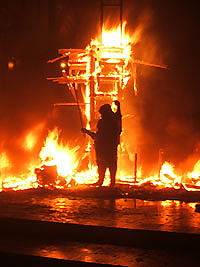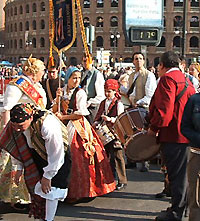
Photo. Crema, from the Fallas festival in Valencia. © Alex Welsh, Valencia Tourist Information, Spain - www.valenciavalencia.com.
Arguably the craziest urban festival in Europe, this is one of the most bizarre and fascinating European attractions, yet it is not a recent invention of new age imagination but a deeply traditional local festivity.
Valencia, the City of Contrast, has stepped firmly into the cosmopolitan 21st century, yet it has kept much of its tradition intact. The social fabric of the city is still organised around the clan-like fallas – neighbourhood co-operatives, reminiscent of Moorish tribal organisation. The falleros comprise a good 30-40% of Valencia. Their main job, apart from being a community, is to stage various fiestas throughout the year, and Las Fallas is their ultimate hay day.
Each of around 350 fallas-communities commissions an effigy – enormous structures made out of papier-mache on a wooden carcass, lavishly painted in bright colours and intricately complex in their themes.
Traditionally, the fallas are satirical. It is everyone’s chance to lash out at whatever troubles them this year – perhaps a public figure or a policy or a development, but more often it is a mocking of society, a brave self-reflection on the morals of today – perhaps greed, vanity, decadence or vulgarity. On this last one – the fallas are definitely for mommy and daddy as the Valencian are particularly fond of sex references in the effigies (sometimes even downright disturbing). However, each falla-community also commissions a children’s falla to be placed side by side with that of the adults.
The fallas cost a lot of money and many months to create. Some poorer ones are less intricate and smaller, according to the budget, while the better sponsored-ones can be up to 30 metres in height and about the same in width. This is the part no foreigner can get a grip on – all this stuff will get burned to the cheers of the crowd.
The Fallas festival advances with much anticipation by the locals, like an unstoppable flood stretching barriers to the limit before bursting out in all its monstrous force.
It simmers throughout the year with the making of the effigies and selections of the Fallera Mayor – the Queen of Fallas who will become the face of Valencia for that one year.
In the end of the February the first petards hit the floor, the first traditional costumes appear on the streets and the first music bands march in the afternoon. On the last Sunday the motley noisy crowd gathers at Torres de Serranos (magnificent Gothic city gates) to be called upon for “the best party in the world” by the Fallera Mayor.
| Photo. Falleros, from the Fallas festival in Valencia. © Alex Welsh, Valencia Tourist Information, Spain - www.valenciavalencia.com. |  |
From then on it’s all uphill. Throughout the first two weeks of March more and more music bands rock the streets, the costumes are everywhere, and the explosions rise in intensity. Every day on the main square there is the mascleta – a mega firecracker insanity that gets this huge square packed with people shaking in jubilant frenzy to the shockwaves of extreme pyrotechnics.
Finally, one week before Las Fallas the first pieces of the effigies begin to arrive for assembly to the crossroads of Valencia’s streets. The falleros break out nomadic camps right on the bitumen nearby and commence their binge-drinking and paella-cooking which now won’t stop for good 10 days.
On the eve of Las Fallas, 15th March, the crowds just can’t hold it in any longer and take to the streets in numbers, while all of the 700 effigies get assembled at the same time. After the fireworks the party goes on till late, with mobile discos breaking out in multiple districts of the city.
| Photo. Falla, from the Fallas festival in Valencia. © Alex Welsh, Valencia Tourist Information, Spain - www.valenciavalencia.com. |  |
The next morning the lucid trip begins. Huge and wacky caricatures grin at you from everywhere you look. Distorted and twisted Mme Tussauds has taken over the city. Music bands and street performers line the pavements. The city bursts at the influx of visitors, up to 3 times its normal population. Smell of gunpowder everywhere. Ears ringing from an explosion every 5 seconds. Paellas cooked right on the roads. Battle for survival in the main square at midday, with the mascleta sending shockwaves through the sea of packed bodies. Lucid groups of locals with all colours of the rainbow on their gold-woven costumes skip in frenzy to their traditional music through the streams of human traffic.
At midnight the mascleta gives way to a castillo – visual fireworks that make your jaw drop. Valencians are the Mozart of fireworks, often doing major sports events and New Year celebrations all over the world. Here they bring the best of the best for their own fiesta, and this is the most lucid transcendent stuff you have ever seen in the sky.
As sunset there is always a spectacle in the centre – a parade of Folklore or a parade of Fire. Next to the main square an altar of offerings takes two days to complete – an enormous statue of the Virgin is made entirely of flowers, brought in ceremonious parades by the falls-communities who stop every few minutes to have a good old dance. These will take two whole days, 14 hours each day, to all bring their flowers, coming out from every corner and every direction, like streams joining one colourful river.
That’s just by day. By night the wild and the deliciously dark rules this place. The whole city is given to the crowds for a mega-party on every single street. Hundreds and hundreds of thousands drink and go wild together at numerous mobile concerts and discos, amongst a total war of explosions and absolute urban chaos and anarchy, as if the government has collapsed.
Yet in the morning there is no time to sleep. Up early and back to the mayhem of colours.
And like this for four days.
No-one sleeps.
Finally, on the 19th those who have survived drag themselves over to the effigies. In extreme tiredness, now oblivious to explosions, people stand, swaying, in wait of the final act. Another mega-tirade of all kinds of pyrotechnics and the fire starts licking the sides of the effigies. Suddenly the flames expand into giant multi-storey size fireballs and fire columns, the heat wave sweeps the crowds and ignites the spirits once again. Huge chunks of effigies fall off into oblivion, raising clouds of sparks, ash and thick smoke all over the city, their last moment of final glory reflecting in the widely open eyes of the entranced onlookers.
The firemen finish the job.
The people crawl home.
Four days of insanity, colours, explosions, noise, music, fireworks, party, mayhem, chaos, crowds and fire. Four days without sleep.
Next morning the streets are clean as if nothing had happened. Business as usual.
Alex Welsh, 25 June 2007
Additional information
Alex is the webmaster of Valencia Travel Information - an independent resource on travelling in Valencia, Spain - www.valenciavalencia.com.














